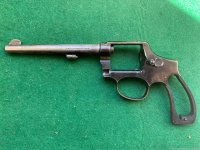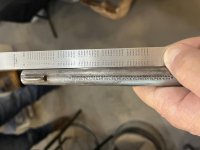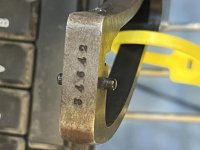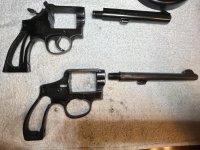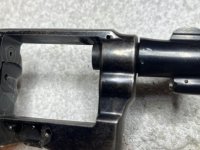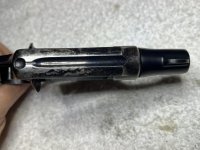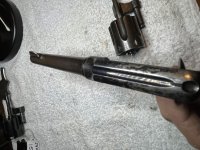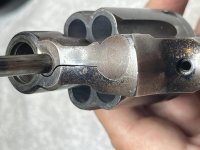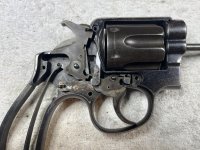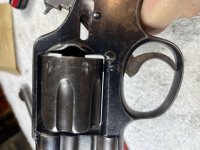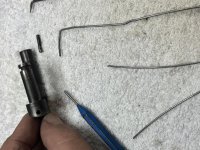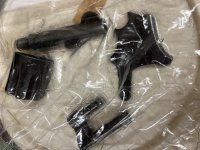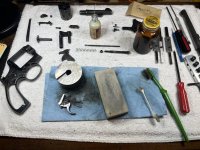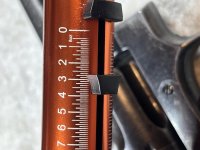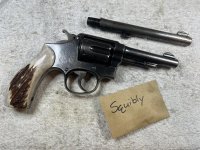Up next was a deep, deep clean on all the crusty parts from the kit and installing the barrel.
The barrel snugged up nicely...and then gave me the first of what turned out to be many, many little things that had to be fixed. The pin wouldn't go in.
I could see light through the hole and a #52 drill bit slipped through easily but the pin just wouldn't go. It turned out that the pin notch in the barrel was just enough out of place in Squibly's frame that it needed a gentle swipe with a #51 bit to widen the channel enough for the pin.
With the barrel in place I was able to measure the cylinder gap and endshake. We had a gap of .007" and no endshake at all. That would become important in a few minutes....
The yoke fit the frame but needed some adjustments to make it align properly. The yoke barrel needed to move inward, so the gauge was left in the barrel as a support and a soft lead babbitt bar was used to thump the yoke barrel enough to make it align.
All of my previous measurements of the cylinder-to-frame fit had been with the barrel off. Now that the barrel was in place I had started having difficulty opening and closing the cylinder. The rear face of the cylinder was rubbing against the frame stop when the cylinder was open. I used a yoke barrel squaring tool to reduce the length of the yoke barrel by .001" and tried it again. That gave me enough clearance that the cylinder would open and close without binding on the frame stop. Adding another thousandth of endshake is on my list of things to do, but I want to shoot Squibly a bit and see how everything else shakes out before I do that.
Next on the list was the sear click. I didn't want to mess with the angle on the end of the double action sear, so I began by stoning the adjustment foot to let the sear out a bit more. Eleventy-seven cycles of test-disassemble-stone-reassemble-test got me exactly nowhere. The trigger bevel was hitting the double action sear straight on and it appeared that I would have to take a truly significant amount off of the sear adjustment foot to move the sear out enough to stop the click.
As I was trying to figure out how to set up my sear jig to attack the bottom of the double action sear without totally screwing up the angles, my eye fell on the parts kits that had supplied Squibly's internals. Hey....the other kit has a different style of hammer with a double action sear that is shaped much differently. What would happen if......
Yep. Swapping the hammers completely fixed the sear click. Now that I think about it, I'm pretty sure that I had been trying to put a post-war transitional hammer into a pre-war action. I had incorrectly assumed that because the parts arrived together they should stay together. Nope.



